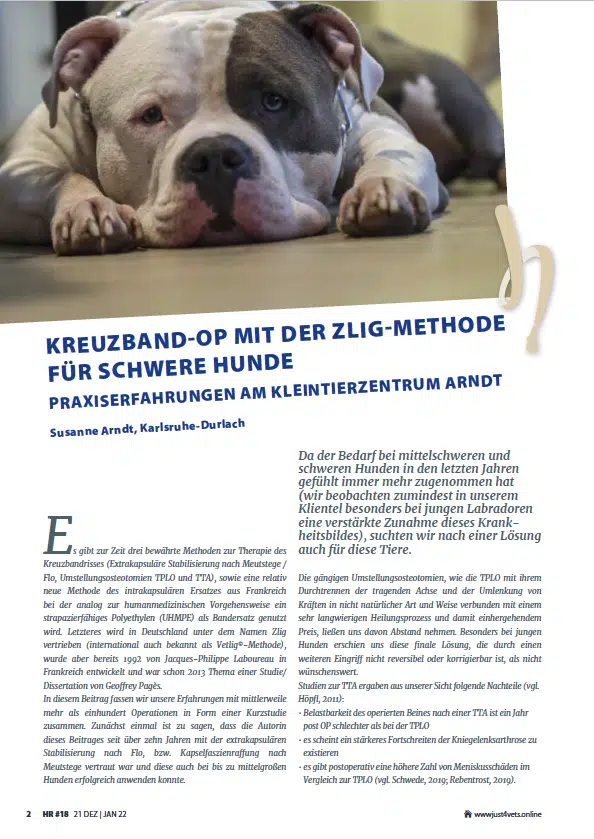The ZLig method has been used on humans for 25 years. Instead of the torn cruciate ligament, the body's own or artificial material (tendons, parts of the patellar ligament, fascia) is used as a ligament replacement.
This method has not been tested on dogs for a long time. Due to the insufficiently controllable load on the knee joints in dogs after the operation, the ligament replacement ruptured again in many cases.
With Zlig, after a long preparation period by Dr. Jacques Pillipe Laboureau, a synthetic band for intra-articular cruciate ligament replacement offers a new alternative in small animals.
Using a tunnel technique, the Zlig is used as a total cruciate ligament replacement. The braided extra-articular portions of the ligaments are anchored in the femoral and tibial bone canals with cannulated titanium interference screws.
With the development of new materials in medical technology, it is now possible to perform a surgical method on dogs/cats that is considered state-of-the-art in humans because it better replicates the animal's natural anatomy and, in contrast to TPLO/TTA, does not cause any stressful changes brings the bone with it.
Operation method
We have shared our experiences from over 200 Zlig operations in an article on Just4vets, among others. This also describes exactly the procedure and the success rate. In contrast to the TPLO or TTA conversion techniques, no bones have to be sawn up and moved or fitted with wedges. This can mean advantages in terms of faster resilience and subsequent physiotherapy .

Advantages of ZLig
✓ This technique does not cause irreversible damage.
✓ Can also be used for very heavy dogs >70kg.
✓ Replica of the natural anatomy without serious interventions in the bone structure.
✓ The patient's hind leg can be put under weight again very soon (!) after the operation without any risks (however, we recommend resting on a leash for the first few weeks)
✓ Lower costs than TPLO or TTA when you consider the total effort including follow-up treatment and physiotherapy.
✓ In suitable young animals that have suffered a traumatic cruciate ligament tear (e.g. due to an accident) and that are not predisposed to cruciate ligament tears, this method does not prevent the subsequent use of TPLO or TTA - however, these are one - off and final If problems arise again, in the worst case scenario this means amputation.
✓ in older animals and with bilateral ligament tears, both ligament tears can be treated in one operation using the Petlig Method® developed by us (one-time anesthesia risk; parallel operation of both knees by two surgeons = shortened operation time, etc.) and the animal is quick (here: Example of a 14-year-old dog two days after the operation) is able to move again and has a better quality of life
Disadvantages of ZLig
X higher costs than with Meutstege capsuloplasty or lateral suture .
X not suitable for dogs with steep tibeal plateau such as Old English Bulldog, Dobermans etc.
